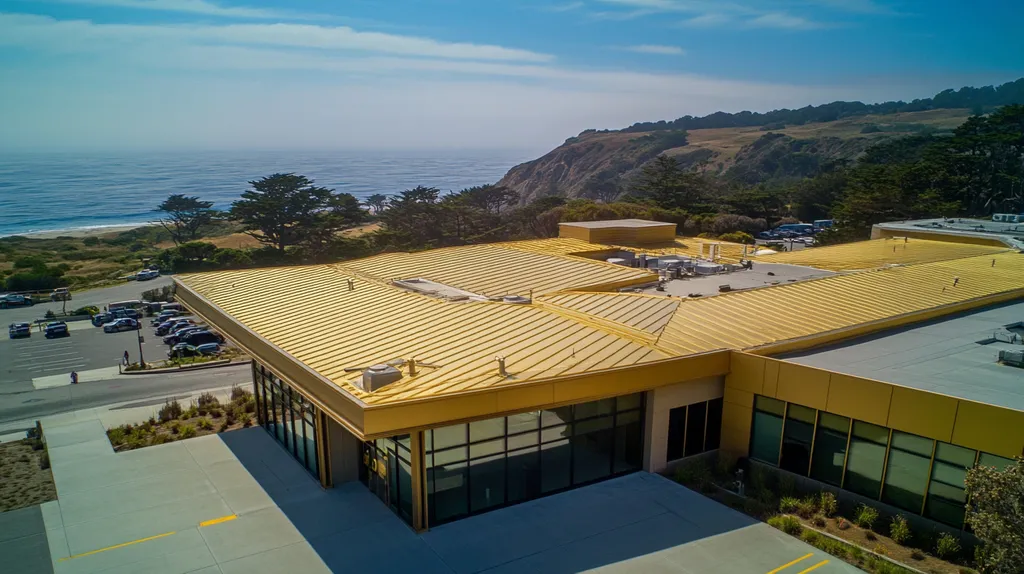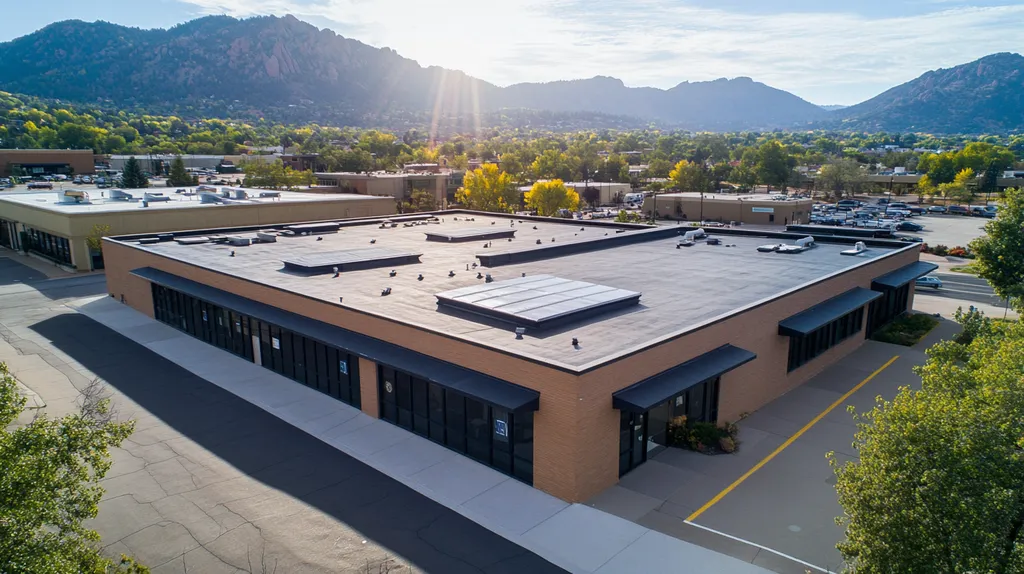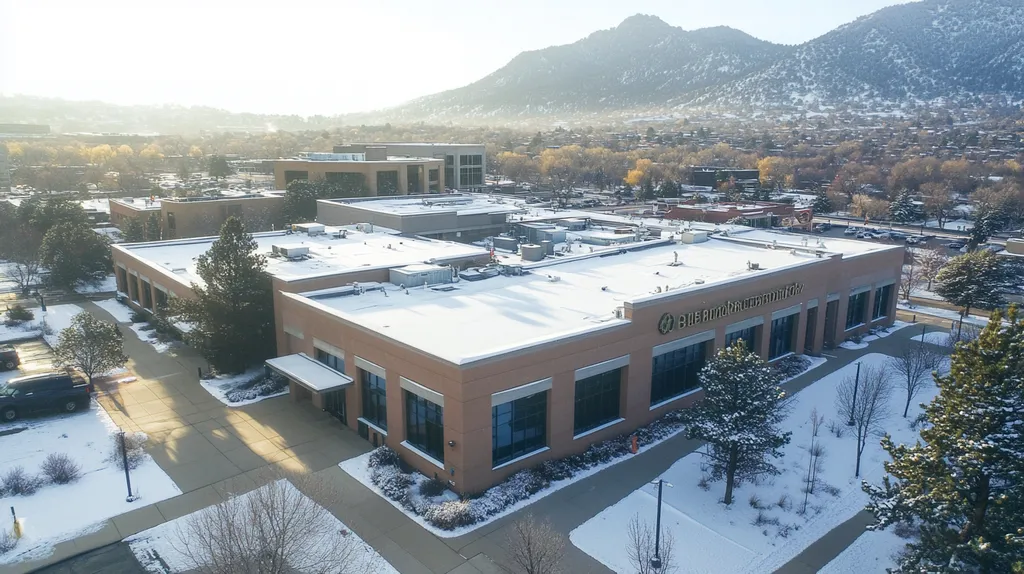Commercial buildings consume over 40% of America’s total energy, with roofing systems directly impacting up to 30% of that usage. This massive environmental footprint represents both a crisis and an opportunity.
As climate change accelerates and energy costs soar, property owners face mounting pressure to adopt sustainable roofing solutions. Modern eco-friendly systems can reduce cooling costs by up to 50% while extending roof lifespans beyond traditional limits.
This comprehensive guide examines the materials, methods, and metrics that define successful sustainable commercial roofing, providing property owners with actionable strategies for environmental and financial optimization.
SECTION 1: FUNDAMENTAL CONCEPTS
Commercial roofing decisions today have far-reaching environmental consequences. Buildings consume approximately 40% of America’s total energy, with roofing systems playing a crucial role in this consumption. As climate change intensifies and energy costs rise, property owners face increasing pressure to adopt sustainable roofing solutions that balance environmental responsibility with operational efficiency.
Principles of Eco-Friendly Roofing Design
Eco-friendly roofing starts with material selection and installation methods that minimize environmental impact. These choices affect not only the building’s carbon footprint but also its long-term operational costs.
The foundation of sustainable roofing lies in using recycled or renewable materials. This includes options like reclaimed metal, recycled rubber, or sustainably harvested wood products.
Installation techniques matter as much as materials. Proper insulation placement, air barrier systems, and ventilation design work together to maximize energy efficiency.
Smart design also incorporates future adaptability. Roofing systems should accommodate later additions like solar panels or green roof sections without requiring complete replacement.
Environmental Benefits of Sustainable Roofs
Sustainable roofs deliver measurable environmental improvements beyond energy savings. They reduce stormwater runoff by up to 75%, decreasing pressure on municipal drainage systems.
Green roofs act as natural air filters, capturing airborne pollutants and converting carbon dioxide to oxygen. A 1,000-square-foot green roof can remove several pounds of particulates from the air annually.
These roofing systems create urban wildlife habitats, supporting local biodiversity. Even simple modifications like native plant sections can provide crucial stopping points for migrating birds.
The cumulative effect of widespread sustainable roofing adoption could significantly reduce urban heat island effects, potentially lowering city temperatures by several degrees.
Climate Considerations for Eco Roofing in the U.S.
Climate zones across the U.S. demand different roofing approaches for optimal environmental performance. White or light-colored roofs excel in reducing cooling costs and environmental impact in warmer regions, while darker materials prove more efficient in cooler climates. (source: Metal and Shingle Roofing Systems)
Regional weather patterns also influence material selection. Areas with heavy rainfall require excellent drainage systems and water-resistant materials, while regions prone to high winds need enhanced attachment methods.
Local building codes and environmental regulations vary significantly by region. Understanding these requirements helps property owners maximize available incentives while ensuring compliance.
Successful eco-roofing projects account for both immediate climate conditions and projected changes over the roof’s expected lifespan.
SECTION 2: SYSTEM COMPONENTS
Commercial roofing technology has evolved dramatically, offering unprecedented opportunities for environmental stewardship and cost reduction. Modern system components can reduce energy consumption by up to 50% while extending roof lifespans beyond traditional limits. Understanding these components is crucial as building owners face increasing pressure to meet sustainability goals and combat rising energy costs.
Sustainable Roofing Materials and Membranes
Fibre cement has emerged as a leading sustainable roofing material, offering exceptional durability and versatility for commercial applications. Its inherent resistance to fire, moisture, and insects makes it particularly valuable in high-humidity regions, while its reduced manufacturing energy footprint supports environmental goals. (source: Parametric Architecture)
Recycled rubber membranes represent another breakthrough in sustainable roofing. These materials divert waste from landfills while providing superior waterproofing and UV resistance.
Bio-based membranes derived from agricultural byproducts offer renewable alternatives to petroleum-based products. These materials decompose naturally at end-of-life, minimizing environmental impact.
Installation methods for sustainable materials have also evolved, with cold-applied adhesives replacing traditional hot-applied systems to reduce VOC emissions and improve worker safety.
Reflective and Insulating Roof Coverings
Modern reflective coatings can reduce roof surface temperatures by up to 60°F, dramatically decreasing cooling demands. These coatings utilize advanced ceramic technologies to reflect solar radiation while maintaining durability.
Multi-layer insulation systems combine traditional and phase-change materials to optimize thermal performance. This innovation helps buildings maintain consistent temperatures with minimal energy input.
Cool roof technologies now incorporate self-cleaning surfaces that maintain reflectivity without regular maintenance. These surfaces preserve energy-saving properties while reducing maintenance costs.
Strategic placement of insulation layers prevents thermal bridging, eliminating a major source of energy loss in commercial buildings.
Integrated Renewable Energy Components
Building-integrated photovoltaics (BIPV) merge seamlessly with modern roofing systems, generating power while maintaining waterproof integrity. These systems eliminate the need for separate mounting hardware and reduce installation costs.
Solar thermal collectors integrated into roofing panels provide efficient water heating capabilities. This dual-purpose approach maximizes limited roof space while reducing energy consumption.
Smart monitoring systems track renewable energy production and roof performance in real-time. This data enables proactive maintenance and optimizes energy generation.
Energy storage solutions connected to rooftop renewable systems help buildings achieve energy independence. These systems provide backup power during outages while reducing peak demand charges.
SECTION 3: IMPLEMENTATION METHODS
The successful implementation of eco-friendly commercial roofing requires careful planning, precise execution, and thorough understanding of regulatory requirements. Studies show that improper installation can negate up to 70% of potential energy savings from sustainable roofing systems. As building codes evolve and environmental standards tighten, facility managers must navigate complex decisions about materials, techniques, and compliance to maximize their return on investment.
Installation Techniques for Eco-Friendly Roofs
Proper installation begins with comprehensive roof deck preparation. This includes moisture testing, structural assessment, and precise grading to ensure optimal drainage patterns.
Layer sequencing plays a crucial role in sustainable roof performance. Each component must be installed in specific order – from vapor barriers through insulation to final membrane – to create an integrated system.
Seam welding and overlap specifications require particular attention with eco-friendly materials. These connection points often determine the overall system integrity and energy performance.
Modern installation methods emphasize minimal waste and reduced environmental impact during construction. This includes using electric-powered equipment where possible and implementing strict material recycling protocols.
Retrofit Strategies for Existing Commercial Roofs
The first step in any retrofit project is a thorough assessment of the existing roof structure. This evaluation determines load-bearing capacity for additional sustainable components and identifies areas requiring repair.
Strategic phasing allows businesses to maintain operations during retrofits. Careful planning can divide large projects into manageable sections while maintaining building protection.
Cool roof conversions often provide the fastest return on investment. Simple modifications like applying reflective coatings can reduce cooling costs by 25-40% in single-story buildings.
Modular green roof systems offer flexible retrofit solutions. These pre-grown sections can be installed progressively, allowing properties to spread costs while immediately gaining benefits.
Compliance with Building Codes and Standards
Modern building codes increasingly emphasize sustainability and energy efficiency. The U.S. Environmental Protection Agency supports programs that exceed traditional minimum requirements, helping jurisdictions establish more robust environmental standards. (source: U.S. Environmental Protection Agency)
Documentation requirements for eco-friendly installations have become more stringent. Contractors must maintain detailed records of materials, installation methods, and performance metrics.
Regular inspections throughout the installation process help ensure compliance. These checkpoints verify proper technique, material quality, and adherence to specifications.
Many jurisdictions now require post-installation performance testing. These evaluations measure actual energy efficiency gains and environmental benefits against projected targets.
SECTION 4: MAINTENANCE REQUIREMENTS
Maintenance can make or break an eco-friendly roofing investment, with studies showing that poorly maintained sustainable roofs lose up to 40% of their energy-saving potential within five years. Regular upkeep ensures optimal performance of reflective coatings, solar installations, and vegetative systems while protecting the substantial financial investment these systems represent. Understanding and implementing proper maintenance protocols is crucial for maximizing both environmental benefits and return on investment.
Routine Inspection and Cleaning Protocols
Professional inspections should occur quarterly, with special attention to drainage systems, membrane seams, and penetration points. These checkpoints prevent small issues from escalating into major repairs.
Regular cleaning maintains reflective surface performance and prevents biological growth that can degrade roofing materials. Monthly debris removal from drains and gutters prevents water accumulation that can compromise roof integrity.
Documentation through detailed inspection reports and photographs creates a maintenance history that helps identify recurring issues. This data enables predictive maintenance and more efficient budget allocation.
Winter preparations require special attention to prevent ice dam formation and protect sensitive components. Removal of snow buildup helps maintain structural integrity and system performance.
Repair Practices for Sustainable Roofing Systems
Fibre cement roofing systems demand specific maintenance protocols to preserve their fire and moisture resistance properties. Regular cleaning and proper repair techniques ensure these materials maintain their exceptional durability while supporting integrated solar installations. (source: Parametric Architecture)
Repairs must maintain system integrity without compromising environmental benefits. Using compatible sustainable materials preserves both performance and eco-friendly characteristics.
Addressing minor repairs promptly prevents escalation into major system failures. Small membrane tears or loose seams can quickly lead to widespread damage if left unchecked.
Temperature fluctuations require special attention to expansion joints and flashings. Regular inspection of these components prevents separation and water infiltration.
Managing Vegetative and Solar Roof Components
Vegetative roof maintenance requires specialized knowledge of both horticulture and roofing systems. Monthly inspections should assess plant health, irrigation efficiency, and drainage performance.
Solar panel maintenance focuses on maximizing energy production through regular cleaning and performance monitoring. Quarterly cleaning prevents output degradation from dirt and debris accumulation.
Integration points between different system components need careful attention. Where solar mounts penetrate membranes or vegetation meets hard surfaces, regular inspection prevents water infiltration.
Seasonal adjustments to irrigation and fertilization schedules optimize plant health while protecting underlying roofing components. This balance maintains both aesthetic appeal and system functionality.
SECTION 5: PERFORMANCE METRICS
Performance metrics serve as the foundation for informed commercial roofing decisions, yet many property owners lack clear evaluation frameworks. With commercial buildings consuming over 40% of U.S. energy and roofing systems directly impacting up to 30% of that usage, understanding key metrics becomes crucial. Modern eco-friendly roofing solutions offer unprecedented opportunities to reduce environmental impact while delivering measurable financial returns – but only when properly evaluated through specific, actionable metrics.
Energy Efficiency and Thermal Performance
Energy performance starts with comprehensive thermal analysis. Advanced infrared mapping can identify heat loss patterns and optimize insulation placement for maximum efficiency.
Modern cool roofing systems can reduce peak cooling demand by 15-25% in single-story buildings. This translates to significant cost savings, particularly in warmer climates where cooling loads dominate energy usage.
Solar reflectance index (SRI) ratings provide standardized comparisons between roofing materials. Higher SRI values indicate better heat reflection and improved thermal performance.
Real-time monitoring systems now track thermal performance continuously. This data helps facility managers optimize HVAC operations and verify energy savings.
Durability and Lifespan Assessment
Durability metrics focus on resistance to environmental stressors including UV exposure, temperature cycling, and moisture penetration. Advanced testing protocols can simulate decades of wear within controlled environments.
Life-cycle analysis tools evaluate total ownership costs across the entire system lifespan. This includes initial materials, installation labor, maintenance requirements, and eventual disposal costs.
Physical testing measures puncture resistance, tear strength, and seam integrity. These metrics help predict performance under various stress conditions.
Modern eco-friendly materials often demonstrate superior durability compared to traditional options, with some systems lasting 40+ years versus 15-20 for conventional roofs.
Environmental Impact and ROI Measurement
The U.S. Department of Energy emphasizes programs that exceed traditional building requirements, helping jurisdictions establish more robust environmental standards for new construction. (source: U.S. Department of Energy)
Carbon footprint calculations consider manufacturing processes, transportation impacts, and operational emissions. Complete assessment includes both direct and indirect environmental effects.
ROI calculations must incorporate available tax incentives, utility rebates, and increased property values. Many regions offer substantial financial benefits for sustainable roofing adoption.
Stormwater management benefits can be quantified through reduced municipal fees and decreased infrastructure loads. Some cities offer specific credits for green roof installations.
Environmental performance metrics increasingly influence property valuations and leasing decisions. Buildings with documented sustainability features often command premium rates.
SECTION 6: OPTIMIZATION STRATEGIES
Modern commercial roofing optimization represents a critical intersection of technology, sustainability, and financial performance. Studies show that poorly optimized roofing systems waste up to 40% of their potential energy savings while reducing building asset value. With energy costs continuing to rise and environmental regulations tightening, property owners must leverage proven optimization strategies to maximize both sustainability and return on investment.
Enhancing Energy Savings with Roof Design
Spray Polyurethane Foam (SPF) has emerged as a leading optimization solution, providing both roofing protection and superior insulation in a single application. When properly installed, SPF creates a seamless, airtight barrier that dramatically improves temperature retention and reduces HVAC load. (source: Preferred Roofing Services)
Strategic roof slope design maximizes drainage while reducing material stress. Proper pitch calculations prevent water pooling and extend system lifespan.
Ventilation placement significantly impacts energy performance. Balanced air flow reduces heat buildup and moisture accumulation, protecting both insulation effectiveness and structural integrity.
Advanced membrane systems with integrated insulation layers provide exceptional thermal resistance. These composite solutions deliver superior performance while simplifying installation and maintenance.
Combining Green Roofs with Solar Technologies
Integration of vegetative systems with solar installations requires careful balance of competing needs. Proper spacing ensures plants receive adequate sunlight while solar panels maintain optimal exposure.
Smart irrigation systems help maintain vegetative health without compromising solar efficiency. Automated controls prevent overwatering while ensuring consistent plant coverage.
Module positioning must account for both immediate and future shading patterns. Strategic placement maximizes energy generation while allowing for plant growth.
Combined systems often deliver greater benefits than either technology alone. The cooling effect of vegetation can improve solar panel efficiency by up to 15%.
Lifecycle Cost Analysis and Sustainability Planning
Comprehensive lifecycle analysis must consider both direct and indirect costs. Initial installation, maintenance requirements, energy savings, and eventual replacement all factor into total ownership costs.
Performance degradation rates vary significantly between systems. High-quality materials often demonstrate superior value despite higher upfront costs.
Regular assessment of system performance helps identify optimization opportunities. Monitoring key metrics enables proactive adjustments to maximize efficiency.
Environmental benefits increasingly translate to financial advantages. Properties with optimized sustainable roofing systems often command premium rents and higher resale values.
The Bottom Line
With commercial buildings responsible for 40% of U.S. energy consumption and roofing directly impacting up to 30% of that usage, the transition to sustainable roofing systems has become a critical environmental and financial imperative.
Modern eco-friendly roofing technologies can slash energy costs by 50% while extending system lifespans beyond 40 years.
From advanced materials like fibre cement and recycled rubber to integrated solar and vegetative systems, property owners now have unprecedented options for maximizing sustainability.
Success requires careful attention to design, implementation, and maintenance, supported by rigorous performance metrics and optimization strategies.
The future of commercial roofing lies in these sustainable solutions – not just as environmental choices, but as sound business investments that deliver measurable returns.
FREQUENTLY ASKED QUESTIONS
Q. Why is a commercial roof’s environmental impact significant?
A. A commercial roof affects energy consumption and environmental sustainability, accounting for significant energy use. Eco-friendly choices help reduce operational costs and support climate change mitigation.
Q. What are the best materials for an industrial roof?
A. Sustainable materials for industrial roofs include fibre cement, recycled rubber membranes, and bio-based options. Each provides unique benefits, enhancing durability and reducing environmental impact over traditional materials.
Q. How do I ensure compliance with commercial roofing standards?
A. Understanding local codes and maintaining detailed documentation assists compliance with commercial roofing standards. Regular inspections and a thorough installation process help ensure adherence to regulations.
Q. What routine maintenance does a commercial roof require?
A. Routine maintenance includes quarterly inspections and regular cleaning of drainage systems. Keeping reflective surfaces clean and addressing minor repairs promptly helps prevent significant damage and maintains efficiency.
Q. What metrics measure a commercial roof’s performance?
A. Key metrics include energy efficiency, thermal performance, durability, and environmental impact. Regular assessments ensure that the roof meets performance goals and delivers expected returns on investment.
Q. How can I optimize my commercial roofing system?
A. Optimization strategies include enhancing energy efficiency with proper design and integrating renewable components. Regular assessments and adjustments ensure maximum sustainability and financial return over the roof’s lifespan.
Q. Are there incentives for using eco-friendly roofing options?
A. Yes, many regions offer tax incentives, utility rebates, and grants for adopting eco-friendly roofing solutions. Research local programs to maximize financial benefits while enhancing sustainability strategies.










